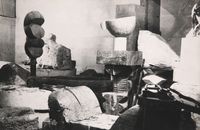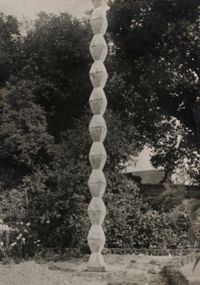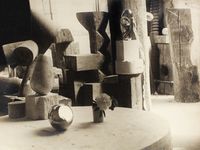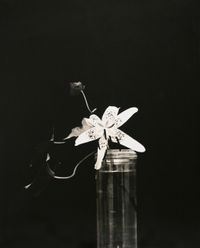Constantin Brâncuși was a pioneering sculptor whose innovative approach to depicting form paved the way for future developments in Modernism and abstraction. His sculptures such as The Kiss (1907—1908) and Bird in Space (1923) are recognised as significant turning points in 20th-century art.
Read MoreBorn in Hobita, a rural village in Romania, Brâncuși studied at the Craiova School of Arts and Crafts from 1894 to 1898. From 1898 to 1901, he attended the Bucharest School of Fine Arts, where he focused on sculpture.
In 1904, Brâncuși moved to Paris, where he commenced study at the École des Beaux-Arts the following year. He was quickly accepted in Parisian avantgarde circles and exhibited at the Salon d'Automne. Brâncuși spent two years working in the studio of Antonin Mercié, and later assisted briefly in Auguste Rodin's studio.
Brâncuși's international reputation advanced with his inclusion in the 1913 Armory Show and in Alfred Stieglitz's 1914 exhibition at the Photo-Secession gallery in New York. His profile continued to grow throughout Europe and the U.S., where he presented in many exhibitions throughout his lifetime.
Constantin Brâncuși rejected the figurative and realist approaches to sculpture that dominated 19th-century Western art, and instead turned to 'primitive' and non-Western art for inspiration. The hundreds of sculptures he produced over his career, the majority of figures or birds in various levels of abstraction, are recognised as a definitive departure from pre-existing artistic styles.
While cast bronze was a common sculptural medium at the time, Brâncuși's works were typically cut directly from materials including marble and sandstone, drawing from the carving and woodworking skills he had learned in his formative years. This allowed for an inventive, direct approach through which the artist aimed to evoke the form of his subjects rather than portray an imitation.
Brâncuși's 'Bird in Space' series comprised numerous iterations of an abstract, elongated bird form, rendered in different materials including marble, bronze, and plaster. His first Bird in Space (1923) was carved from marble. With no defining bird-like features, such as wings, eyes, or feathers, the sculpture considers the bird's movement as its primary subject, elevated by a cylindrical, often multi-tiered base.
Brâncuși became known for the attention he paid to the pedestals upon which his sculptures rested. Rendered in marble, wood, or limestone, these pedestals were seamlessly integrated to operate as both a functional and aesthetic form. They were often used to position the sculpture at a specific height that related to what was depicted—with portraits often standing at eye-level, or birds elevated overhead.
In what is widely acknowledged to be the first instance of an artist integrating an existing sculpture into another's pedestal, Brâncuși's first bird sculpture Maiastra (1910—1912) stood on a three-tiered limestone plinth, the middle tier of which was the elongated sculpture Double Caryatid (c. 1908). The title referencing a Romanian mythical creature, Maiastra combined narrative with formal concerns and a fluidity that would define Brâncuși's oeuvre.
Brâncuși also produced photographs and drawings, which would often serve as preparatory studies or documentation of his sculptures—as seen in photographs such as Vue d'Atelier, Adam et Coupe, Eve (1921—1922) or Endless Column (In Edward Steichen's Garden at Voulangis) (1932).
With the guidance of friend and artist Man Ray, Brâncuși also worked with film, featuring subjects ranging from recordings of himself in the studio, or of artistic influences such as light, animals, and movement.
In 1935, Brâncuși developed a suite of large-scale outdoor sculptures commissioned for a war memorial at Târgu Jiu in Romania, which included Endless Column, The Table of Silence, and The Gate of the Kiss. Endless Column, made up of 16 stacked rhomboids, stands at nearly 30 metres high and was intended to symbolise infinity, in acknowledgement of the Romanian soldiers' sacrifice.
Brâncuși completed his last sculptural work Grand Coq in 1949. He died in 1957 in Paris.
Constantin Brâncuși's works have been exhibited internationally in solo and group exhibitions since the early 20th century, and continue to be presented in major museums and galleries today. His first retrospective was presented at New York's Solomon R. Guggenheim Museum in 1955, and further retrospectives have been held at the Philadelphia Museum of Art (1995); Tate Modern, London (2004); and the Museum of Modern Art, New York (2018), among others.
Misong Kim | Ocula | 2022








